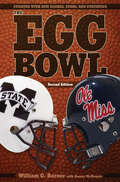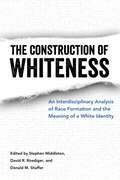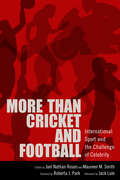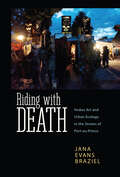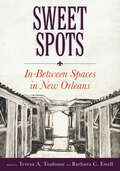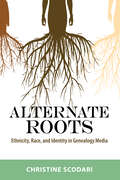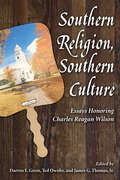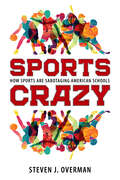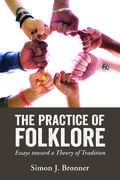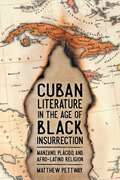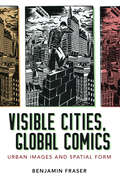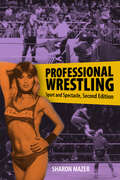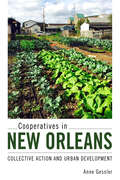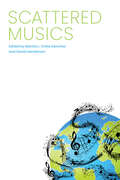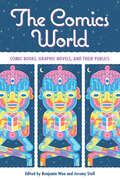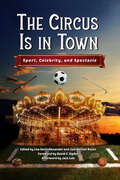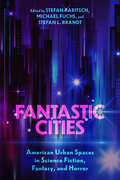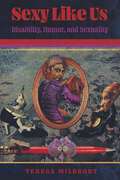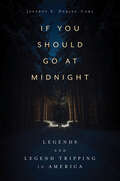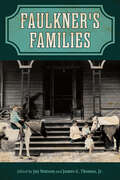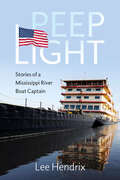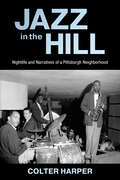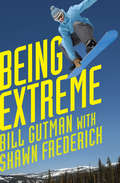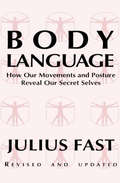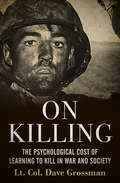- Table View
- List View
The Egg Bowl: Mississippi State vs. Ole Miss, Second Edition
by William G. BarnerFrom the contentious delay of the first clash in 1901 to the battle in 2009, The Egg Bowl covers the Ole Miss–Mississippi State rivalry in depth. For each game the narrative includes every scoring drive, every player who crossed the goal line, and every final score. More than 150 photos illustrate the intensity of action on the field and capture the players and exploits faithful fans will always remember. This updated edition features full accounts of the games in 2007, 2008, and 2009, including new photos and statistics. For the booster who demands to know every statistic, The Egg Bowl creates the ultimate reference. Which player has scored the most touchdowns? Who rushed for the longest run or threw the longest touchdown pass? How many kickoffs have been returned for touchdowns? Why is November 30 of consequence? Which two men have coached at both schools? And surprisingly, which three players have lettered at Mississippi State and Ole Miss? The intensity of the rivalry cannot be understated. Student leaders created the treasured Golden Egg, trophy of the yearly contest, to quell frequent fisticuffs in the stands. While intended to cool the fervor, the Egg has been controversially remodeled, refurbished, and even kidnapped. The story continually simmers. This ideal gift for the football fanatic will only stoke those passions.
The Construction of Whiteness: An Interdisciplinary Analysis of Race Formation and the Meaning of a White Identity
by Stephen Middleton David R. Roediger Donald M. ShafferA CHOICE Outstanding Academic Title, 2017This volume collects interdisciplinary essays that examine the crucial intersection between whiteness as a privileged racial category and the various material practices (social, cultural, political, and economic) that undergird white ideological influence in America. In truth, the need to examine whiteness as a problem has rarely been grasped outside academic circles. The ubiquity of whiteness--its pervasive quality as an ideal that is at once omnipresent and invisible--makes it the very epitome of the mainstream in America. And yet the undeniable relationship between whiteness and inequality in this country necessitates a thorough interrogation of its formation, its representation, and its reproduction. Essays here seek to do just that work. Editors and contributors interrogate whiteness as a social construct, revealing the underpinnings of narratives that foster white skin as an ideal of beauty, intelligence, and power.Contributors examine whiteness from several disciplinary perspectives, including history, communication, law, sociology, and literature. Its breadth and depth makes The Construction of Whiteness a refined introduction to the critical study of race for a new generation of scholars, undergraduates, and graduate students. Moreover, the interdisciplinary approach of the collection will appeal to scholars in African and African American studies, ethnic studies, cultural studies, legal studies, and more. This collection delivers an important contribution to the field of whiteness studies in its multifaceted impact on American history and culture.
More than Cricket and Football: International Sport and the Challenge of Celebrity
by Jack LuleContributions by Lisa Doris Alexander, Sean Bell, Benn L. Bongang, Joel S. Franks, Silvana Vilodre Goellner, Annette R. Hofmann, Dong Jinxia, Cláudia Samuel Kessler, Jack Lule, Li Luyang, Mark Panek, Roberta J. Park, Gamage Harsha Perera, Joel Nathan Rosen, Viral Shah, Maureen M. Smith, Nancy E. Spencer, Dominic Standish, Tim B. Swartz, Dan Travis, Theresa Walton-Fisette, and Zhong YijingGiven the presumed dominance of American sport, many fans throughout the hemisphere find it difficult to envision the role of sport beyond the confines of their own continent. And yet, world sport consists of so much more than the games Americans play and so much more than the stereotype of cricket for the elite and football for the working class. As worldwide sport continues to gain in popularity, we also see parallels to many aspects visible in North American sport, particularly celebrity and all its trappings and pitfalls.The success of athletes from other countries in basketball and ice hockey, and the proliferation of stars imported and now exported to and from North America, provides some better examples of sport’s international power. It also creates a very new kind of sport celebrity, albeit one that often shows a rather limited reach beyond that star’s own country or continent. Thus, rather than focusing on the Western Hemisphere, this collection of some of world sport’s most heralded celebrities (including stars of Motocross, surfing, distance running, and more) serves as a sort of passport to many places that make up our global sporting environment.
Riding with Death: Vodou Art and Urban Ecology in the Streets of Port-au-Prince (Caribbean Studies Series)
by Jana Evans BrazielOn the southern end of the Grand Rue, a major thoroughfare that runs through the center of Port-au-Prince, waits the Haitian capital's automobile repair district. This veritable junkyard of steel and rubber, recycled parts, old tires, and scrap metal might seem an unlikely foundry for art. Yet, on the street's opposite end thrives the Grand Rue Galerie, a working studio of assembled art and sculptures wrought from the refuse.Established by artists André Eugène and Jean Hérard Celeur in the late 1990s, the Grand Rue's urban environmental aesthetics--defined by motifs of machinic urbanism, Vodou bricolage, the postprimitivist altermodern, and performative politics--radically challenge ideas about consumption, waste, and environmental hazards, as well as consider innovative solutions to these problems in the midst of poverty, insufficient social welfare, lack of access to arts, education, and basic needs.In Riding with Death, Jana Evans Braziel explores the urban environmental aesthetics of the Grand Rue sculptors and the beautifully constructed sculptures they have designed from salvaged automobile parts, rubber tires, carved wood, and other recycled materials. Through first-person accounts and fieldwork, Braziel constructs an urban ecological framework for understanding these sculptures amid environmental degradation and grinding poverty. Above all, Braziel presents Haitian artists who live on the most challenged Caribbean island, yet who thrive as creators reinventing refuse as art and resisting the abjection of their circumstances.
Sweet Spots: In-Between Spaces in New Orleans
by Teresa A. Toulouse and Barbara C. EwellContributions by Carrie Bernhard, Scott Bernhard, Marilyn R. Brown, Richard Campanella, John P. Clark, Joel Dinerstein, Pableaux Johnson, John P. Klingman, Angel Adams Parham, Bruce Boyd Raeburn, Ruth Salvaggio, Christopher Schaberg, Teresa A. Toulouse, and Beth WillingerMuch has been written about New Orleans's distinctive architecture and urban fabric, as well as the city's art, literature, and music. There is, however, little discussion connecting these features. Sweet Spots--a title drawn from jazz musicians' name for the space "in-between" performers and dancers where music best resonates--provides multiple connections between the city's spaces, its complex culture, and its future.Drawing on the late Tulane architect Malcolm Heard's ideas about "interstitial" spaces, this collection examines how a variety of literal and represented "in-between" spaces in New Orleans have addressed race, class, gender, community, and environment. As scholars of architecture, art, African American studies, English, history, jazz, philosophy, and sociology, the authors incorporate materials from architectural history and practice, literary texts, paintings, drawings, music, dance, and even statistical analyses. Interstitial space refers not only to functional elements inside and outside of many New Orleans houses--high ceilings, hidden staircases, galleries, and courtyards--but also to compelling spatial relations between the city's houses, streets, and neighborhoods.Rich with visual materials, Sweet Spots reveals the ways that diverse New Orleans spaces take on meanings and accrete stories that promote certain consequences both for those who live in them and for those who read such stories. The volume evokes, preserves, criticizes, and amends understanding of a powerful and often-missed feature of New Orleans's elusive reality.
Alternate Roots: Ethnicity, Race, and Identity in Genealogy Media (Race, Rhetoric, and Media Series)
by Christine ScodariIn recent years, the media has attributed the increasing numbers of people producing family trees to the aging of baby boomers, a sense of mortality, a proliferation of Internet genealogy sites, and a growing pride in ethnicity. A spate of new genealogy-themed television series and Internet-driven genetic ancestry testing services have now emerged, capitIn recent years, the media have attributed the increasing numbers of people producing family trees to the aging of baby boomers, a sense of mortality, a proliferation of Internet genealogy sites, and a growing pride in ethnicity. A spate of new genealogy-themed television series and Internet-driven genetic ancestry testing services have now emerged, capitalizing on the mapping of the human genome in 2003. This genealogical trend poses a need for critical analysis, particularly along lines of race and ethnicity. In contextual ways, as she intersperses an account of her own journey chronicling her Italian and Italian American family history, Christine Scodari lays out how family historians can understand intersections involving race and/or ethnicity and other identities inflecting families. Through engagement in and with genealogical texts and practices, such as the classic television series Roots, Ancestry.com, and Henry Louis Gates’s documentaries, Scodari also explains how to interpret their import to historical and ongoing relations of power beyond the family. Perspectives on hybridity and intersectionality gesture toward making connections not only between and among identities, but also between localized findings and broader contexts that might, given only cursory attention, seem tangential to chronicling a family history. Given current tools, texts, practices, cultural contexts, and technologies, Scodari’s study determines whether a critical genealogy around race, ethnicity, and intersectional identities is viable. She delves into the implications of adoption, orientation, and migration while also investigating her own genealogy, examining the racial, ethnic experiences of her forebears and positioning them within larger, cross-cultural contexts.There is little research on genealogical media in relation to race and ethnicity. Thus, Scodari blends cultural studies, critical media studies, and her own genealogy as a critical pursuit to interrogate issues bound up in the nuts-and-bolts of engaging in family history.alizing on the mapping of the human genome in 2003. This genealogical trend poses a need for critical analysis, particularly along lines of race and ethnicity.In contextual ways, Christine Scodari lays out how family historians can understand intersections involving race and/or ethnicity within families. Through engagement in and with genealogical texts and practices, such as the classic television series Roots, Ancestry.com, and Henry Louis Gates’ documentaries, Scodari also explains how to decipher their import to historical and ongoing relations of power beyond the family. Perspectives on hybridity and intersectionality gesture toward making connections not only between and among identities, but also between localized findings and broader contexts that might, given only cursory attention, seem tangential to chronicling a family history.Given current tools, texts, practices, cultural contexts, and technologies, Scodari’s study determines whether a critical genealogy around race, ethnicity, and intersectional identities is viable. She delves into the implications of adoption, orientation, and migration while also investigating her own genealogy, examining the racial, ethnic experiences of her forebears and positioning them within larger, cross-cultural contexts.There is little research on genealogical media in relation to race and ethnicity. Thus, Scodari blends cultural studies, critical media studies, and her own genealogy as a critical pursuit to interrogate issues bound up in the nuts-and-bolts of engaging in family history.
Southern Religion, Southern Culture: Essays Honoring Charles Reagan Wilson (Chancellor Porter L. Fortune Symposium in Southern History Series)
by Darren E. Grem, Ted Ownby, and James G. ThomasContributions by Ryan L. Fletcher, Darren E. Grem, Paul Harvey, Alicia Jackson, Ted Ownby, Otis W. Pickett, Arthur Remillard, Chad Seales, and Randall J. StephensOver more than three decades of teaching at the University of Mississippi, Charles Reagan Wilson’s research and writing transformed southern studies in key ways. This volume pays tribute to and extends Wilson’s seminal work on southern religion and culture. Using certain episodes and moments in southern religious history, the essays examine the place and power of religion in southern communities and society. It emulates Wilson’s model, featuring both majority and minority voices from archives and applying a variety of methods to explain the South’s religious diversity and how religion mattered in many arenas of private and public life, often with life-or-death stakes.The volume first concentrates on churches and ministers, and then considers religious and cultural constructions outside formal religious bodies and institutions. It examines the faiths expressed via the region’s fields, streets, homes, public squares, recreational venues, roadsides, and stages. In doing so, this book shows that Wilson’s groundbreaking work on religion is an essential part of southern studies and crucial for fostering deeper understanding of the South’s complicated history and culture.
Sports Crazy: How Sports Are Sabotaging American Schools
by Steven J. OvermanSports Crazy: How Sports Are Sabotaging American Schools exposes the excesses of middle and high school sports and the detrimental effects our sports obsession has on American education. Institutions are increasingly emulating college and professional sports models and losing sight of a host of educational and health goals.Steven J. Overman describes how this agenda is driven largely by partisan fans and parents of athletes who exert an inordinate influence on school priorities, and he explains how and why school administrators shockingly and consistently capitulate to these demands. The author underscores the incongruity of public schools involved in an entertainment business and the effects this diversion has on academic integrity, learning, life experience, and overall educational outcomes.Overman examines out-of-control school sports within the context of a school’s educational mission and curriculum, with telling reference to impacts on physical education. He explores as well the outsized place of interscholastic sports beyond the classroom and scrutinizes the distorted relationship between intramural or recreational sports and elitist, varsity athletics. Overman’s chapter on tackle football explains many reasons why this sport should be eliminated from the school extracurriculum and replaced by flag or touch football.Overman presents a brief history of interscholastic sports, and he compares and contrasts the American experience of school-sponsored sport to the European model of community-based clubs. Which approach better serves students? Overman recommends reforms in the context of a radical proposal to phase out interscholastic sports in favor of an intramural or club model. This approach would alleviate such problems as elitism and gender bias and reign in hypercompetitiveness while freeing schools to educate students rather than provide public entertainment.
The Practice of Folklore: Essays toward a Theory of Tradition
by Simon J. BronnerWinner of the 2020 Chicago Folklore PrizeCHOICE Outstanding Academic Title for 2020Despite predictions that commercial mass culture would displace customs of the past, traditions firmly abound, often characterized as folklore. In The Practice of Folklore: Essays toward a Theory of Tradition, author Simon J. Bronner works with theories of cultural practice to explain the social and psychological need for tradition in everyday life. Bronner proposes a distinctive “praxic” perspective that will answer the pressing philosophical as well as psychological question of why people enjoy repeating themselves. The significance of the keyword practice, he asserts, is the embodiment of a tension between repetition and variation in human behavior. Thinking with practice, particularly in a digital world, forces redefinitions of folklore and a reorientation toward interpreting everyday life. More than performance or enactment in social theory, practice connects localized culture with the vernacular idea that “this is the way we do things around here.” Practice refers to the way those things are analyzed as part of, rather than apart from, theory, thus inviting the study of studying. “The way we do things” invokes the social basis of “doing” in practice as cultural and instrumental. Building on previous studies of tradition in relation to creativity, Bronner presents an overview of practice theory and the ways it might be used in folklore and folklife studies. Demonstrating the application of this theory in folkloristic studies, Bronner offers four provocative case studies of psychocultural meanings that arise from traditional frames of action and address issues of our times: referring to the boogieman; connecting “wild child” beliefs to school shootings; deciphering the offensive chants of sports fans; and explicating male bravado in bawdy singing. Turning his analysis to the analysts of tradition, Bronner uses practice theory to evaluate the agenda of folklorists in shaping perceptions of tradition-centered “folk societies” such as the Amish. He further unpacks the culturally based rationale of public folklore programming. He interprets the evolving idea of folk museums in a digital world and assesses how the folklorists' terms and actions affect how people think about tradition.
Cuban Literature in the Age of Black Insurrection: Manzano, Plácido, and Afro-Latino Religion (Caribbean Studies Series)
by Matthew PettwayJuan Francisco Manzano and Gabriel de la Concepción Valdés (Plácido) were perhaps the most important and innovative Cuban writers of African descent during the Spanish colonial era. Both nineteenth-century authors used Catholicism as a symbolic language for African-inspired spirituality. Likewise, Plácido and Manzano subverted the popular imagery of neoclassicism and Romanticism in order to envision black freedom in the tradition of the Haitian Revolution. Plácido and Manzano envisioned emancipation through the lens of African spirituality, a transformative moment in the history of Cuban letters. Matthew Pettway examines how the portrayal of African ideas of spirit and cosmos in otherwise conventional texts recur throughout early Cuban literature and became the basis for Manzano and Plácido’s antislavery philosophy. The portrayal of African-Atlantic religious ideas spurned the elite rationale that literature ought to be a barometer of highbrow cultural progress. Cuban debates about freedom and selfhood were never the exclusive domain of the white Creole elite. Pettway’s emphasis on African-inspired spirituality as a source of knowledge and a means to sacred authority for black Cuban writers deepens our understanding of Manzano and Plácido not as mere imitators but as aesthetic and political pioneers. As Pettway suggests, black Latin American authors did not abandon their African religious heritage to assimilate wholesale to the Catholic Church. By recognizing the wisdom of African ancestors, they procured power in the struggle for black liberation.
Visible Cities, Global Comics: Urban Images and Spatial Form
by Benjamin FraserCHOICE Outstanding Academic Title for 2020More and more people are noticing links between urban geography and the spaces within the layout of panels on the comics page. Benjamin Fraser explores the representation of the city in a range of comics from across the globe. Comics address the city as an idea, a historical fact, a social construction, a material-built environment, a shared space forged from the collective imagination, or as a social arena navigated according to personal desire. Accordingly, Fraser brings insights from urban theory to bear on specific comics. The works selected comprise a variety of international, alternative, and independent small-press comics artists, from engravings and early comics to single-panel work, graphic novels, manga, and trading cards, by artists such as Will Eisner, Tsutomu Nihei, Hariton Pushwagner, Julie Doucet, Frans Masereel, and Chris Ware. In the first monograph on this subject, Fraser touches on many themes of modern urban life: activism, alienation, consumerism, flânerie, gentrification, the mystery story, science fiction, sexual orientation, and working-class labor. He leads readers to images of such cities as Barcelona, Buenos Aires, London, Lyon, Madrid, Montevideo, Montreal, New York, Oslo, Paris, São Paolo, and Tokyo. Through close readings, each chapter introduces readers to specific comics artists and works and investigates a range of topics related to the medium’s spatial form, stylistic variation, and cultural prominence. Mainly, Fraser mixes interest in urbanism and architecture with the creative strategies that comics artists employ to bring their urban images to life.
Professional Wrestling: Sport and Spectacle, Second Edition (Performance Studies Series)
by Sharon MazerProfessional wrestling is one of the most popular performance practices in the United States and around the world, drawing millions of spectators to live events and televised broadcasts. The displays of violence, simulated and actual, may be the obvious appeal, but that is just the beginning. Fans debate performance choices with as much energy as they argue about their favorite wrestlers. The ongoing scenarios and presentations of manly and not-so-manly characters—from the flamboyantly feminine to the hypermasculine—simultaneously celebrate and critique, parody and affirm the American dream and the masculine ideal. Sharon Mazer looks at the world of professional wrestling from a fan’s-eye-view high in the stands and from ringside in the wrestlers’ gym. She investigates how performances are constructed and sold to spectators, both on a local level and in the “big leagues” of the WWF/E. She shares a close-up view of a group of wrestlers as they work out, get their faces pushed to the mat as part of their initiation into the fraternity of the ring, and dream of stardom. In later chapters, Mazer explores professional wrestling’s carnivalesque presentation of masculinities ranging from the cute to the brute, as well as the way in which the performances of women wrestlers often enter into the realm of pornographic. Finally, she explores the question of the “real” and the “fake” as the fans themselves confront it. First published in 1998, this new edition of Professional Wrestling: Sport and Spectacle both preserves the original’s snapshot of the wrestling scene of the 1980s and 1990s and features an up-to-date perspective on the current state of play.
Cooperatives in New Orleans: Collective Action and Urban Development
by Anne GesslerCooperatives have been central to the development of New Orleans. Anne Gessler asserts that local cooperatives have reshaped its built environment by changing where people interact and with whom, helping them collapse social hierarchies and envision new political systems. Gessler tracks many neighborhood cooperatives, spanning from the 1890s to the present, whose alliances with union, consumer, and social justice activists animated successive generations of regional networks and stimulated urban growth in New Orleans. Studying alternative forms of social organization within the city’s multiple integrated spaces, women, people of color, and laborers blended neighborhood-based African, Caribbean, and European communal activism with international cooperative principles to democratize exploitative systems of consumption, production, and exchange. From utopian socialist workers’ unions and Rochdale grocery stores to black liberationist theater collectives and community gardens, these cooperative entities integrated marginalized residents into democratic governance while equally distributing profits among members. Besides economic development, neighborhood cooperatives participated in heady debates over urban land use, applying egalitarian cooperative principles to modernize New Orleans’s crumbling infrastructure, monopolistic food distribution systems, and spotty welfare programs. As Gessler indicates, cooperative activists deployed street-level subsistence tactics to mobilize continual waves of ordinary people seizing control over mainstream economic and political institutions.
Scattered Musics
by Martha I. Chew Sánchez and David HendersonContributions by Nilanjana Bhattacharjya, Benjamin Burkhart, Ivy Chevers, Martha I. Chew Sánchez, Athena Elafros, William García-Medina, Sara Goek, David Henderson, Eyvind Kang, Junko Oba, Juan David Rubio Restrepo, and Gareth Dylan SmithIn Scattered Musics, editors Martha I. Chew Sánchez and David Henderson, along with a range of authors from a variety of scholarly backgrounds, consider the musics that diaspora and migrant populations are inspired to create, how musics and musicians travel, and how they change in transit. The authors cover a lot of ground: cumbia in Mexico, música sertaneja in Japan, hip-hop in Canada, Irish music in the US and the UK, reggae and dancehall in Germany, and more. Diasporic groups transform the musical expressions of their home countries as well as those in their host communities. The studies collected here show how these transformations are ways of grappling with ever-changing patterns of movement. Different diasporas hold their homelands in different regards. Some communities try to re-create home away from home in musical performances, while others use music to critique and redefine their senses of home. Through music, people seek to reconstruct and refine collective memory and a collective sense of place.The essays in this volume—by sociologists, historians, ethnomusicologists, and others—explore these questions in ways that are theoretically sophisticated yet readable, making evident the complexities of musical and social phenomena in diaspora and migrant populations. As the opening paragraph of the introduction to the volume observes, “What remains when people have been scattered apart is a strong urge to gather together, to collect.” At few times in our lives has that ever been more apparent than right now.
The Comics World: Comic Books, Graphic Novels, and Their Publics
by Benjamin Woo and Jeremy StollContributions by Bart Beaty, T. Keith Edmunds, Eike Exner, Christopher J. Galdieri, Ivan Lima Gomes, Charles Hatfield, Franny Howes, John A. Lent, Amy Louise Maynard, Shari Sabeti, Rob Salkowitz, Kalervo A. Sinervo, Jeremy Stoll, Valerie Wieskamp, Adriana Estrada Wilson, and Benjamin Woo The Comics World: Comic Books, Graphic Novels, and Their Publics is the first collection to explicitly examine the production, circulation, and reception of comics from a social-scientific point of view. Designed to promote interdisciplinary dialogue about theory and methods in comics studies, this volume draws on approaches from fields as diverse as sociology, political science, history, folklore, communication studies, and business, among others, to study the social life of comics and graphic novels. Taking the concept of a “comics world”—that is, the collection of people, roles, and institutions that “produce” comics as they are—as its organizing principle, the book asks readers to attend to the contexts that shape how comics move through societies and cultures. Each chapter explores a specific comics world or particular site where comics meet one of their publics, such as artists and creators; adaptors; critics and journalists; convention-goers; scanners; fans; and comics scholars themselves. Through their research, contributors demonstrate some of the ways that people participate in comics worlds and how the relationships created in these spaces can provide different perspectives on comics and comics studies. Moving beyond the page, The Comics World explores the complexity of the lived reality of the comics world: how comics and graphic novels matter to different people at different times, within a social space shared with others.
The Circus Is in Town: Sport, Celebrity, and Spectacle
by Jack LuleContributions by Lisa Doris Alexander, Matthew H. Barton, Andrew C. Billings, Carlton Brick, Ted M. Butryn, Brian Carroll, Arthur T. Challis, Roxane Coche, Curtis M. Harris, Jay Johnson, Melvin Lewis, Jack Lule, Rory Magrath, Matthew A. Masucci, Andrew McIntosh, Jorge E. Moraga, Leigh M. Moscowitz, David C. Ogden, Joel Nathan Rosen, Kevin A. Stein, and Henry YuIn this fifth book on sport and the nature of reputation, editors Lisa Doris Alexander and Joel Nathan Rosen have tasked their contributors with examining reputation from the perspective of celebrity and spectacle, which in some cases can be better defined as scandal. The subjects chronicled in this volume have all proven themselves to exist somewhere on the spectacular spectrum—the spotlight seemed always to gravitate toward them. All have displayed phenomenal feats of athletic prowess and artistry, and all have faced a controversy or been thrust into a situation that grows from age-old notions of the spectacle. Some handled the hoopla like the champions they are, or were, while others struggled and even faded amid the hustle and flow of their runaway celebrity. While their individual narratives are engrossing, these stories collectively paint a portrait of sport and spectacle that offers context and clarity. Written by a range of scholarly contributors from multiple disciplines, The Circus Is in Town: Sport, Celebrity, and Spectacle contains careful analysis of such megastars as LeBron James, Tonya Harding, David Beckham, Shaquille O’Neal, Maria Sharapova, and Colin Kaepernick. This final volume of a project that has spanned the first three decades of the twenty-first century looks to sharpen questions regarding how it is that reputations of celebrity athletes are forged, maintained, transformed, repurposed, destroyed, and at times rehabilitated. The subjects in this collection have been driven by this notion of the spectacle in ways that offer interesting and entertaining inquiry into the arc of athletic reputations.
Fantastic Cities: American Urban Spaces in Science Fiction, Fantasy, and Horror
by Stefan Rabitsch, Michael Fuchs and Stefan L. BrandtContributions by Carl Abbott, Jacob Babb, Marleen S. Barr, Michael Fuchs, John Glover, Stephen Joyce, Sarah Lahm, James McAdams, Cynthia J. Miller, Fernando Gabriel Pagnoni Berns, Chris Pak, María Isabel Pérez Ramos, Stefan Rabitsch, J. Jesse Ramírez, A. Bowdoin Van Riper, Andrew Wasserman, Jeffrey Andrew Weinstock, and Robert Yeates Metropolis, Gotham City, Mega-City One, Panem’s Capitol, the Sprawl, Caprica City—American (and Americanized) urban environments have always been a part of the fantastic imagination. Fantastic Cities: American Urban Spaces in Science Fiction, Fantasy, and Horror focuses on the American city as a fantastic geography constrained neither by media nor rigid genre boundaries. Fantastic Cities builds on a mix of theoretical and methodological tools that are drawn from criticism of the fantastic, media studies, cultural studies, American studies, and urban studies. Contributors explore cultural media across many platforms such as Christopher Nolan’s Dark Knight Trilogy, the Arkham Asylum video games, the 1935 movie serial The Phantom Empire, Kim Stanley Robinson’s fiction, Colson Whitehead’s novel Zone One, the vampire films Only Lovers Left Alive and A Girl Walks Home Alone at Night, Paolo Bacigalupi’s novel The Water Knife, some of Kenny Scharf’s videos, and Samuel Delany’s classic Dhalgren. Together, the contributions in Fantastic Cities demonstrate that the fantastic is able to “real-ize” that which is normally confined to the abstract, metaphorical, and/or subjective. Consequently, both utopian aspirations for and dystopian anxieties about the American city become literalized in the fantastic city.
Sexy Like Us: Disability, Humor, and Sexuality
by Teresa MilbrodtSexy Like Us: Disability, Humor, and Sexuality takes a humorous, intimate approach to disability through the stories, jokes, performances, and other creative expressions of people with disabilities. Author Teresa Milbrodt explores why individuals can laugh at their leglessness, find stoma bags sexual, discover intimacy in scars, and flaunt their fragility in ways both hilarious and serious. Their creative and comic acts crash, collide, and collaborate with perceptions of disability in literature and dominant culture, allowing people with disabilities to shape political disability identity and disability pride, call attention to social inequalities, and poke back at ableist cultural norms. This book also discusses how the ambivalent nature of comedy has led to debates within disability communities about when it is acceptable to joke, who has permission to joke, and which jokes should be used inside and outside a community’s inner circle. Joking may be difficult when considering aspects of disability that involve physical or emotional pain and struggles to adapt to new forms of embodiment. At the same time, people with disabilities can use humor to expand the definitions of disability and sexuality. They can help others with disabilities assert themselves as sexy and sexual. And they can question social norms and stigmas around bodies in ways that open up journeys of being, not just for individuals who consider themselves disabled, but for all people.
If You Should Go at Midnight: Legends and Legend Tripping in America
by Jeffrey S. Debies-CarlTonight, across America, countless people will embark on an adventure. They will prowl among overgrown headstones in forgotten graveyards, stalk through darkened woods and wildlands, and creep down the crumbling corridors of abandoned buildings. They have set forth in search of a profound paranormal experience and may seem to achieve just that. They are part of the growing cultural phenomenon called legend tripping.In If You Should Go at Midnight: Legends and Legend Tripping in America, author Jeffrey S. Debies-Carl guides readers through an exploration of legend tripping, drawing on years of scholarship, documentary accounts, and his own extensive fieldwork. Poring over old reports and legends, sleeping in haunted inns, and trekking through wilderness full of cannibal mutants and strange beasts, Debies-Carl provides an in-depth analysis of this practice that has long fascinated scholars yet remains a mystery to many observers.Debies-Carl argues that legend trips are important social practices. Unlike traditional rites of passage, they reflect the modern world, revealing both its problems and its virtues. In society as well as in legend tripping, there is ambiguity, conflict, crisis of meaning, and the substitution of debate for social consensus. Conversely, both emphasize individual agency and values, even in spiritual matters. While people still need meaningful and transformative experiences, authoritative, traditional institutions are less capable of providing them. Instead, legend trippers voluntarily search for individually meaningful experiences and actively participate in shaping and interpreting those experiences for themselves.
Faulkner's Families (Faulkner and Yoknapatawpha Series)
by Jay Watson and James G. ThomasContributions by Josephine Adams, Jeff Allred, Garry Bertholf, Maxwell Cassity, John N. Duvall, Katherine Henninger, Maude Hines, Robert Jackson, Julie Beth Napolin, Rebecca Nisetich, George Porter Thomas, Jay Watson, and Yuko YamamotoIf it seems outrageous to suggest that one of the twentieth century’s most important literary cartographers of the private recesses of consciousness is also among its great novelists of family, William Faulkner nonetheless fits the bill on both counts. Family played an outsized role in both his life and his writings, often in deeply problematic ways, surfacing across his oeuvre in a dazzling range of distorted, defamiliarized, and transgressive forms, while on other occasions serving as a crucible for crushing forces of conformity, convention, and tradition. The dozen essays featured in this collection approach Faulkner’s many families—actual and imagined—as especially revealing windows to his work and his world. Contributors explore the role of the child in Faulkner’s vision of family and regional society; sibling relations throughout the author's body of work; the extension of family networks beyond blood lineage and across racial lines; the undutiful daughters of Yoknapatawpha County; the critical power of family estrangement and subversive genealogies in Faulkner’s imagination; forms of queer and interspecies kinship; the epidemiological imagination of Faulkner’s notorious Snopes family as social contagion; the experiences of the African American families who worked on the writer’s Greenfield Farm property; and Faulkner’s role in promoting a Cold War–era ideology of “the family of man” in post–World War II Japan.
Peep Light: Stories of a Mississippi River Boat Captain
by Lee HendrixMost people only consider the Mississippi River when they cross it or when it inconveniently abandons its banks. But every year, millions of tons of cargo are transported by towboats on the river. In Peep Light: Stories of a Mississippi River Boat Captain, Captain Lee Hendrix provides unique insight on people who work and live on and near the Mississippi River. Hendrix, formerly a pilot for the Delta Queen Steamboat Co., has worked on the Mississippi for fifty years, first as a towboat deckhand in 1972 and eventually as a pilot of towboats and passenger vessels. In 2014, Hendrix became captain of the towboat Mississippi with the US Army Corps of Engineers, then he later retired to return to passenger vessels. For Hendrix and others like him, he is at home on the river, living and dining with the same people they work with, working with familiar faces for years at a time and yet meeting new people every day.Demonstrating a fascination not only with the river but also with the passions and dreams of those who live and work on it, these stories range from personal reflections on aging, experiencing one’s first night on the river and the complex emotions that come with it, working on the deck, promotion to pilot, the characters working aboard these boats, and the history of the river itself. Peep Light unites humans with the river through engaging storytelling and sheds light on Hendrix’s rare experience along one of the most powerful and important waterways in the world.
Jazz in the Hill: Nightlife and Narratives of a Pittsburgh Neighborhood (American Made Music Series)
by Colter HarperFrom the 1920s through the 1960s, Pittsburgh’s Hill District was the heart of the city’s Black cultural life and home to a vibrant jazz scene. In Jazz in the Hill: Nightlife and Narratives of a Pittsburgh Neighborhood, Colter Harper looks at how jazz shaped the neighborhood and created a way of life. Beyond backdrops for remarkable careers, jazz clubs sparked the development of a self-determined African American community. In delving into the history of entrepreneurialism, placemaking, labor organizing, and critical listening in the Hill District, Harper forges connections to larger political contexts, processes of urban development, and civil rights struggles.Harper adopts a broad approach in thinking about jazz clubs, foregrounding the network of patrons, business owners, and musicians who were actively invested in community building. Jazz in the Hill provides a valuable case study detailing the intersections of music, political and cultural history, public policy, labor, and law. The book addresses distinctive eras and issues of twentieth century American urban history, including notions of “vice” during the Prohibition Era (1920–1934); “blight” during the mid-twentieth century boom in urban redevelopment (1946–1973); and workplace integration during the civil rights era (1954–1968). Throughout, Harper demonstrates how the clubs, as a nexus of music, politics, economy, labor, and social relations, supported the livelihood of residents and artists while developing cultures of listening and learning. Though the neighborhood has undergone an extensive socioeconomic transformation that has muted its nightlife, this musical legacy continues to guide current development visions for the Hill on the cusp of its remaking.
Being Extreme: Thrills and Dangers in the World of High-Risk Sports
by Bill GutmanAs fast-paced as a freefall from a roaring airplane, as thrilling as a towering jump off a ski slope, Being Extreme is a fascinating examination of the adrenaline rush of extreme sports. Here is a world where living life on the edge is the only option, where you are only as good as your last jump . . . and where one false move can take you out of the game permanently.From mountain climbing and freestyle motocross to skydiving and snowboarding and beyond, in the past decade, the world of extreme sports has exploded onto the scene, with daredevils attempting acts of athleticism that leave spectators awed . . . and fearful. Being Extreme explores the motivations and societal impulses behind these high-risk lifestyles through interviews with professional athletes and recreational enthusiasts, as well as with psychiatrists who seek to understand the motivation behind these &“Big T&” personalities. Authors Gutman and Frederick also explore what heart-stopping sports are around the next curve, because in a world where the &“rush&” is everything, everyone is always upping their game.
Body Language: The Essential Secrets Of Non-verbal Communication
by Julius FastA revised and updated edition of the New York Times–bestselling classic on understanding body language from the author of Subtext.Body Language helps you to understand the unconscious body movements and postures that provide intimate keys to what a person is really thinking and the secrets of their true inner selves. You will learn how to read the angle of shoulders, the tilt of a head, or the tap of a foot, in order to discern whether an individual is angry, frightened, or cheerful. You will be able to use Body Language to discover the most—and least—important person in any group by the way others position themselves. The body is not able to lie, for it sends subtle signals to those who know how to read them. Body Language will even show you how to do it without others knowing you are observing them. Body Language was a huge best seller when first published and has remained in print ever since. It has been thoroughly updated and revised especially for this ebook edition.
On Killing: The Psychological Cost of Learning to Kill in War and Society
by Lt. Col. Dave GrossmanA controversial psychological examination of how soldiers&’ willingness to kill has been encouraged and exploited to the detriment of contemporary civilian society. Psychologist and US Army Ranger Dave Grossman writes that the vast majority of soldiers are loath to pull the trigger in battle. Unfortunately, modern armies, using Pavlovian and operant conditioning, have developed sophisticated ways of overcoming this instinctive aversion. The mental cost for members of the military, as witnessed by the increase in post-traumatic stress, is devastating. The sociological cost for the rest of us is even worse: Contemporary civilian society, particularly the media, replicates the army&’s conditioning techniques and, Grossman argues, is responsible for the rising rate of murder and violence, especially among the young. Drawing from interviews, personal accounts, and academic studies, On Killing is an important look at the techniques the military uses to overcome the powerful reluctance to kill, of how killing affects the soldier, and of the societal implications of escalating violence.
